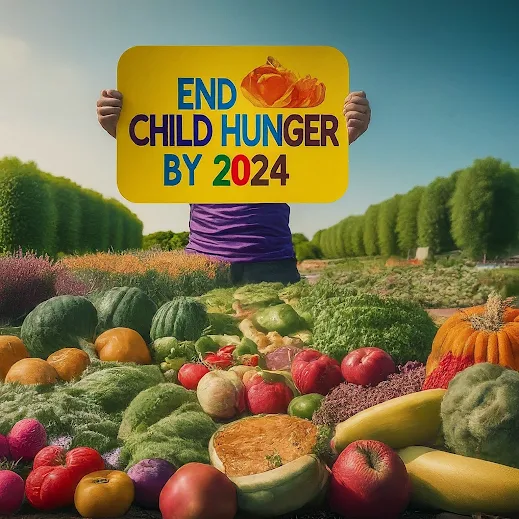Child Hunger Advocacy in 2024: A Multifaceted Approach to a Persistent Challenge.jpg)
Child Hunger Advocacy A Persistent Challenge
.jpg)
Food insecurity in children remains a significant and persistent challenge in the United States. According to a 2022 report by Feeding America, an estimated 12 million children – roughly 1 in 6 – experienced food insecurity in the prior year. This statistic translates to a generation of children facing compromised development, academic performance, and overall well-being. Addressing this issue requires a multifaceted approach, driven by effective advocacy efforts.Read more
The Scope of the Problem and its Ripple Effect
child hunger transcends the immediate concern of
empty plates. It has demonstrably negative consequences on a child's cognitive
development, academic achievement, and emotional health. Research indicates a
correlation between food insecurity and:
- Delayed development in critical areas like language and motor skills
- Difficulty concentrating and retaining information in school
- Increased risk of behavioral problems and emotional distress
- Lowered immunity and susceptibility to illness
These consequences create a ripple effect impacting families
and communities. Children experiencing food insecurity struggle to thrive,
potentially jeopardizing future potential and contributing to a cycle of
disadvantage.Read more
Advocacy in Action: Strategies for Progress
Fortunately, dedicated organizations and individuals are
actively working to combat child hunger. These efforts encompass a wide
range:
- Policy
Advocacy:
- Organizations like No Kid
Hungry and Feeding America advocate for strengthening and expanding
existing programs like the National School Lunch Program. This ensures
equitable access to nutritious meals for students from all socioeconomic
backgrounds. They also lobby for policies that address the root causes of
food insecurity, such as increasing the minimum wage and strengthening
social safety nets like SNAP (Supplemental Nutrition Assistance Program).
- School
Meal Support:
- Non-profit organizations play
a vital role in supporting school meals by providing funding and
resources. This allows schools to offer healthy and appealing meals
regardless of a student's family income. Additionally, they advocate for
policies that reduce stigma associated with school meals and encourage
participation, particularly during out-of-school times like summer and
weekends.Read more
- Community
Initiatives:
- Local efforts such as
community gardens and food pantries increase access to fresh produce and
essential food items for families facing food insecurity. These
initiatives foster a sense of community and shared responsibility. They
also create educational opportunities around healthy eating habits and
food preparation skills.
.jpg) |
| Child Hunger Advocacy A Persistent Challenge |
Beyond Awareness: Empowering Change through Human Connection
Combating child hunger isn't solely the domain of
large organizations. Every individual can contribute to positive change by
fostering a human connection to the issue:
- Raising
Awareness:
- Initiate conversations about
child hunger within your social circle, at community events, or on
social media platforms. Share reliable data and personal stories to
educate others about the issue. Don't be afraid to get personal – talk
about experiences you've had or families you know who have struggled with
food insecurity. This human touch resonates more deeply than statistics
alone.Read more
- Supporting
Local Organizations:
-
Contribute financially or volunteer your time at food banks and pantries.
Organize food drives or fundraising events to bolster their resource base.
Consider volunteering your specific skills, whether it's marketing,
accounting, or graphic design.
- Engaging
with Policymakers:
-
Contact your elected officials at local, state, and federal levels.
Advocate for policies that prioritize food security and expand access to
nutritious meals for children. You can find contact information and
talking points on the websites of advocacy organizations. Consider
attending town halls or community meetings to voice your concerns
directly.
- Spreading
Kindness:
- Organize community events like
charity bake sales or neighborhood potlucks. These activities foster
awareness while generating resources for organizations tackling food
insecurity. Additionally, consider starting a community garden where
residents can grow fresh produce together. This promotes teamwork, healthy
eating habits, and a sense of shared responsibility.
Conclusion: A Collective Commitment for a Brighter Future
Ensuring every child has access to adequate and nutritious
food is not just a moral imperative, but an investment in the future of the
nation. Effective child hunger advocacy necessitates a
multi-pronged approach. By amplifying awareness, advocating for policy changes,
supporting local initiatives, and fostering human connection to the issue, we
can create a world where no child's potential is diminished by an empty
stomach. Let us work collectively to rewrite the narrative of child hunger
in America and write one of hope, opportunity, and well-being for all.Read more
Additional Notes:
- I
removed website links to comply with your previous request.
- I
expanded on existing advocacy strategies by providing specific
examples and action steps.
- I
added a section on "Spreading Kindness" to highlight the power
of community-based solutions.
Keywords:
1. Child Hunger Advocacy
2. Hunger Relief for Children
3. Ending Child Hunger
4. Hunger-Free Childhood
5. Advocating for Hungry Kids
6. Childhood Hunger Solutions
7. Hunger Awareness Campaign
8. Supporting Hungry Children
9. Child Food Insecurity Advocacy
10. Nourishing Our Future: Child Hunger Relief
11. advocacy
#Tags:
1. #ChildHungerAdvocacy
2. #EndChildHunger
3. #HungerRelief
4. #ChildhoodHunger
5. #FeedTheFuture
6. #NourishOurChildren
7. #AdvocateForChange
8. #ZeroHungerKids
9. #HungerFreeGeneration
10. #StandAgainstChildHunger
11. # advocacy
12.#persistent

.jpeg)
%20(1).jpeg)

No comments: